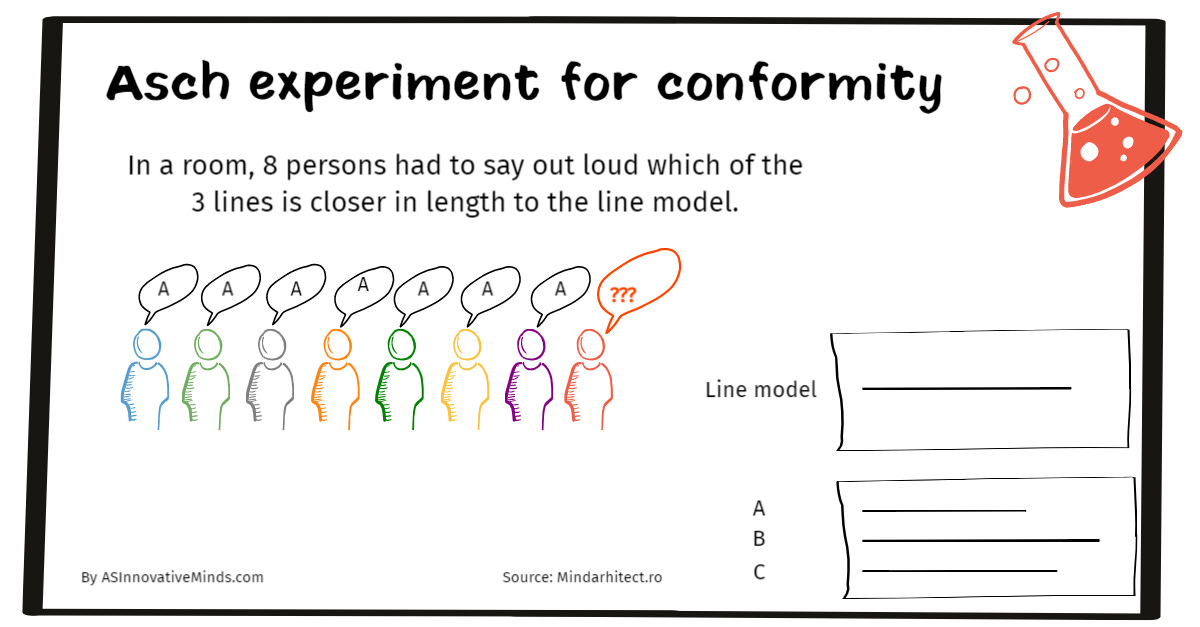Navigating Conformity in Team Settings: Strategies for Facilitators
A neuroscience experiment about conformity
Situation:
You are in a workshop and you have collected ideas, concepts or topics you want to choose from. There are many methods to use like Heat Map, Straw Poll Vote, and so on.
Why is it relevant to know which voting (choosing) method to use depending on your team's personality types? Why is it relevant how you use each method? Why is it relevant to set expectations at the start of this part?
Because there are situations and teams where one is influenced by each other opinion and, of course, you want to avoid this usually.
This post is about explaining why is this happening using a neuroscientific experiment explained in simple words and images and also how you can avoid the influencing of opinions using facilitation.
What is the Asch conformity experiment about?
The initial experiment was done in 1951 in the USA by psychologist Solomon Asch.
In a room, 8 persons had to say out loud which of the 3 lines is closer in length to the line model.
Of all 8, only one was a real participant in the experiment. The other 7 were collaborators of the experiment organizer.
The test was composed of 18 trials and the collaborators were instructed in 12 of the 18 to give the same answer and the answer to be wrong.
Which were the results of this experiment?
3/4 of the real participants were in conformity with the majority wrongly at least 1 time.
1/3 of the real participants were in conformity with the majority wrongly every time
in one of the versions of this experiment when from the 7 collaborators 1 was answering differently than the other 6, and the conformity grade of the real participants was going down to 80 %
Which conclusions were out of this experiment?
People do not conform only verbally, but convince themselves that the majority is right and alter their visual perception.
Social pressure and conformity with the majority phenomenon are very real and it is variating culturally.
The conformity phenomenon has a stronger effect if the opinions of others are brought together in a unanimous opinion.
How you can avoid the influencing of opinions using facilitation in a working session?
🎲 Set expectations: explain to your team what is going to happen before a voting exercise happens. Tell them their vote is important because this is the reason why the working session is created: to hear all voices and each voice is important. Invite them to hold the pressure before choosing their preferred ideas, concepts, and so on, because it is important to be mindful of it. It can be that they are thinking of an argument that the other ones are not and vice-versa.
🎲Create suggestions for success: before they start the working session, make sure you create with your team suggestions for success. How do we want to work together in this session? One of them could be that the managers or senior people talk at the end so that every other person has the opportunity to express their opinions upfront. another idea is to make sure they make their decisions before expressing their arguments on why they chose something. Check for this the Straw Poll Voting sequence for more details on how to do this.
🎲Anonymous voting: for some groups, anonymous voting might be a better fit also depending on the topic they have. It is also relevant if you ask them to do this simultaneously or not. One good example of this is Heat Map Voting.
🎲Give introverts space to talk: There are many aspects here to talk about, but I want to focus on situations where giving introverted persons the opportunity to talk in pairs first, before sharing their arguments with the big group, gives them more comfort in doing so. Try not to put them on the spot, being the first to share their arguments, but also not at the end because for them is hard to wait, it is a stressful thing for them to talk in front of many people and it is easier for them to talk earlier than the others. Find the sweet spot for them, you know them better!
There are many ways of avoiding influencing opinions and it is up to you which one you use. relevant is you can only invite your team to do this, but it is also related to organizational culture and mindset at the end.
One-phrase summary:
Social pressure and conformity with the majority phenomenon are very real and it is variating culturally. As a facilitator, you can guide your team through different methods to avoid this depending on the type of session you have and their personalities.
Resources:
Mindarchitect Mind Snack (Romanian neuroscience podcast)
Want to turn complex information into an eye-catching visual story?
Try Drawify, I got in love ❤️ with it and you can use a special discount (in the link) to play and create visuals as well (I am a Drawify Ambassador).



